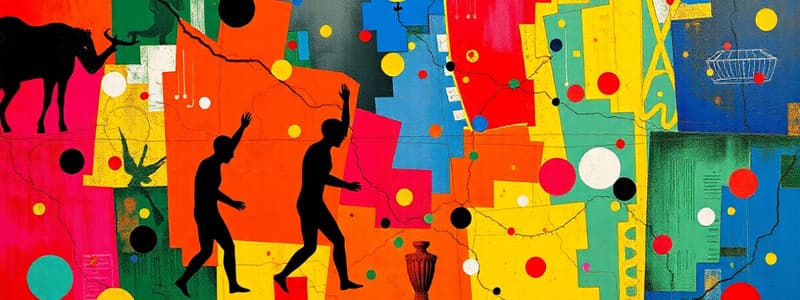Podcast
Questions and Answers
What was the primary means of information sharing during the Prehistoric Era?
What was the primary means of information sharing during the Prehistoric Era?
- Print media and steam-powered machines
- Illustrations, dances, and oral communication (correct)
- The alphabet and recorded drama
- Use of paper and written communication
How did information recording improve during the Ancient Era compared to the Prehistoric Era?
How did information recording improve during the Ancient Era compared to the Prehistoric Era?
- Reliance on petroglyphs and cave paintings
- Development of paper and formation of alphabets (correct)
- Introduction of stone tools for information storage
- Increased use of oral traditions and community gatherings
What key innovation characterized the Industrial Era in terms of media?
What key innovation characterized the Industrial Era in terms of media?
- Invention of steam-powered machines altering information sharing (correct)
- Creation of cuneiform script
- Use of pigments from plants for communication
- Utilization of body art for expression
Which of the following was NOT a characteristic of the information sharing during the Prehistoric Era?
Which of the following was NOT a characteristic of the information sharing during the Prehistoric Era?
What advancements in communication were achieved during the Ancient Era?
What advancements in communication were achieved during the Ancient Era?
Study Notes
Prehistoric Era (200,000 BCE – 4,000 BCE)
- Humans used plant pigments to draw rather than write
- Illustrations, dances, and oral communication were the primary means of sharing information
- Information was limited and shared within small circles
- Information was prone to being lost due to immature recording methods
- Examples of information dissemination include petroglyphs, cave paintings, dance, body art, and stone tools
Ancient Era (3,000 BCE – 100 CE)
- This era saw improvements in recording information compared to the prehistoric era
- Humans began using paper and alphabets for communication
- Culture was better recorded and passed down through generations
- Examples of communication include paper, Cuneiform script, hieroglyphs, the Phoenician and Greek alphabets, and drama
Industrial Era (1440 - 1890)
- The Industrial Revolution and steam-powered machines led to the invention of new media
- The way information was stored and shared changed significantly, allowing humans to reach larger audiences
Studying That Suits You
Use AI to generate personalized quizzes and flashcards to suit your learning preferences.
Related Documents
Description
Explore the fascinating journey of information dissemination from the Prehistoric Era to the Industrial Era. This quiz covers how humans transitioned from primitive methods like cave paintings to more advanced systems such as alphabets and new media during the Industrial Revolution. Test your knowledge on the significant developments in communication throughout history.




